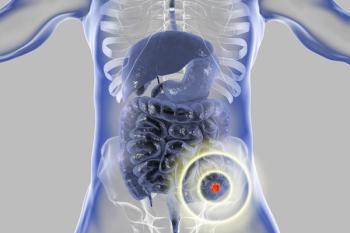
Oncology NEWS International
- Oncology NEWS International Vol 16 No 11
- Volume 16
- Issue 11
Virtual colonoscopy: Is the validation phase finally over?
Compared with optical colonoscopy, CT colonography achieves similar outcomes with a fraction of the number of polypectomies
Compared with optical colonoscopy, CT colonography achieves similar outcomes with a fraction of the number of polypectomies, according to a study of more than 6,200 patients from the University of Wisconsin Medical School.
Perry Pickhardt, MD, associate professor of radiology at Wisconsin, and colleagues reported results in The New England Journal of Medicine in October (Kim et al: 357:1403-1412, 2007). Their experience supports CTC surveillance for polyps sized 6 to 9 mm, rather than polypectomy, according to the authors.
"The 10-mm threshold for polypectomy at asymptomatic screening would probably capture the vast majority of clinically relevant lesions," they said.
The NEJM publication followed on the heels of the release of results from the American College of Radiology Imaging Network (ACRIN) screening trial, which found similar sensitivity and specificity for the two screening techniques (see discussion below). And European trial results were presented only weeks after publication of the Wisconsin data (see below). Supporters hope these studies will help virtual colonoscopy take off in mainstream screening.
NEJM study
In the NEJM study, researchers compared the screening techniques in two different groups of about 3,100 consecutive asymptomatic, average-risk adults. They assessed detection rates of advanced adenomas, defined as polyps ≥ 10 mm or polyps below that size with high-grade dysplasia or a prominent villous component.
CTC detected 123 advanced adenomas (in 3.2% of patients), including 14 invasive cancers. Optical colonoscopy yielded 121 advanced adenomas (in 3.4% of patients), including 4 invasive cancers.
Polyps were placed into three categories: diminutive (
In each screening group, 103 large advanced adenomas were detected. Optical colonoscopy yielded 11 small advanced adenomas, while CTC picked up 5. The figure is lower due to the CTC surveillance approach. Researchers expected there were several small advanced adenomas yet to be found in the surveillance group.
In the CTC group, only 7.9% of patients were referred for therapeutic optical colonoscopy, similar to the ACRIN results. Most patients with small polyps opted for surveillance, and in those already followed up, 96% of polyps were stable or smaller since the original screen.
In the two groups combined, there were 20 advanced adenomas smaller than 10 mm. High-grade dysplasia and invasive carcinoma are rare in polyps under this size threshold, the researchers said.
Of 2,006 polypectomies performed for diminutive polyps during optical colonoscopy, only 4 turned up advanced adenomas. "Such observations reinforce the scarcity of diminutive and small advanced neoplastic lesions and the potential benefits of filtering strategies during CTC," the authors said. CTC's risk profile was also better, with no complications during screening or therapeutic optical colonoscopy vs seven cases of bowel perforation in the optical colonoscopy group.
The eagerly awaited results of the National CT Colonography Trial (ACRIN 6664) showed that CTC is comparable to optical colonoscopy for intermediate to large adenomas.
Virtual imaging had 90% sensitivity and 86% specificity for adenomas 1 cm or larger, according to the results released at the ACRIN 2007 fall meeting. Performance characteristics remained high in smaller polyps, with 84% sensitivity in lesions 7 mm or larger. Specificity remained high (86% to 89%) across all relevant lesion sizes, said principal investigator C. Daniel Johnson, MD, of the Mayo Clinic, Rochester, Minnesota.
The ACRIN trial involved 15 centers and 2,531 asymptomatic patients over age 50. Fifteen radiologist readers were randomly assigned to perform primary interpretations with either 2D or 3D software from a range of vendors. In almost all cases, colonoscopy was performed immediately after the CTC.
Overall, 547 polyps were detected in 390 study patients. About two-thirds of the polyps detected were adenomatous. The mean polyp size was 8.9 mm, and 128 polyps 1 cm or larger were found in 109 patients, equivalent to 4.3% of the study group.
The prevalence of lesions 6 mm or larger was low at 8.3%. Seven cancers 5 mm or larger in size were detected.
"Results indicate most patients undergoing CTC would not need subsequent colonoscopy, sparing them cost, risk, and inconvenience of needing a second test," Dr. Johnson said.
Researchers found the type of scanner or software did not influence outcomes, nor did the type of primary interpretation: 2D or 3D. Dr. Johnson noted that the success of Dr. Pickhardt's study at Wisconsin has been attributed to use of the primary 3D fly-through technique, but, in fact, the 2D reads were as effective as primary 3D reads and required 6 minutes less interpretation time.
Dr. Johnson attributed the trial's success in part to reader training and certification. Participant radiologists had to either read 500 studies or undergo 1.5 days of training, and pass a certifying examination.
Johnson stressed the need for multidisciplinary cooperation. "Radiologists, primary-care doctors, and colonoscopists need to work together so those who do have lesions identified on CTC can go ahead and have the colonoscopy on the same day, obviating the need for a second bowel preparation," he said.
European data bolster argument
A new multicenter study from Italy shows virtual colonoscopy is comparable to gold standard optical colonoscopy for detecting suspicious lesions in patients at higher than normal risk for colorectal cancer. The IMPACT study data were presented at the Eighth Annual Symposium on Virtual Colonoscopy in Boston.
The days when people questioned the performance of CTC appear to be over, based on all of the new data, said study investigator Andrea Laghi, MD, of the University of Rome La Sapienza.
People considered at risk included those who had previously undergone polypectomies and those who had a first-degree relative with an adenoma or adenocarcinoma detected between the ages of 40 and 65.
Among 934 study patients, researchers picked up 203 adenomas, 174 advanced neoplasias, and 42 colorectal cancers. For adenomas ≥ 10 mm, per-patient results showed a sensitivity of 90.7%, specificity of 84.6%, and accuracy of 85.4%. For adenomas ≥ 6 mm, per-patient results were 84.2% sensitivity, 90.4% specificity, and 89.1% accuracy.
The results suggest CTC could be an alternative for surveillance of high-risk patients, the researchers said.
Articles in this issue
about 18 years ago
MT103, BiTE antibody, enters phase II testing for ALLabout 18 years ago
Sides dig in as ESA policy debate heats upabout 18 years ago
Ixempra gets ok for resistant breast cancerabout 18 years ago
ASCO adds Oncotype DX to marker guidelineabout 18 years ago
Dr. Norton hopes to weed 'molecular' tumor gardenabout 18 years ago
Accelerated approval for Tasignaabout 18 years ago
Oxidative stress inducer ups survival in advanced melanomaabout 18 years ago
FDA removes partial hold on Telcyta clinical developmentabout 18 years ago
Should all HER2+ pts receive adjuvant trastuzumab?about 18 years ago
R-CHOP is standard of care for advanced DLBCL patientsNewsletter
Stay up to date on recent advances in the multidisciplinary approach to cancer.
































































































